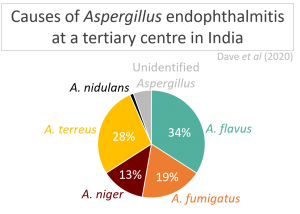Submitted by Aspergillus Administrator on 11 November 2008
A recent study by Willger et al has explored a mechanism required by this mold to cause disease, hypoxia (low oxygen) adaptation. The study states that hypoxia adaptation in Aspergillus fumigatus is mediated in part by a highly conserved transcription factor, SrbA, a protein in the sterol regulatory element binding protein family.
A mutant strain, not expressing SrbA was found to be unable to grow in hypoxic conditions, it also displayed increased susceptibility to the azole class of antifungal drugs – specifically it was highly susceptible to fluconazole and voriconazole, and was unable to cause disease in two distinct murine models of IPA.
Importantly, the authors report the discovery of a novel function of SrbA in molds related to maintenance of cell polarity. The finding that SrbA regulates resistance to the azole class of antifungal drugs presents an opportunity to uncover new mechanisms of antifungal drug resistance in A. fumigatus. Further details.
News archives
-
Title
Date



